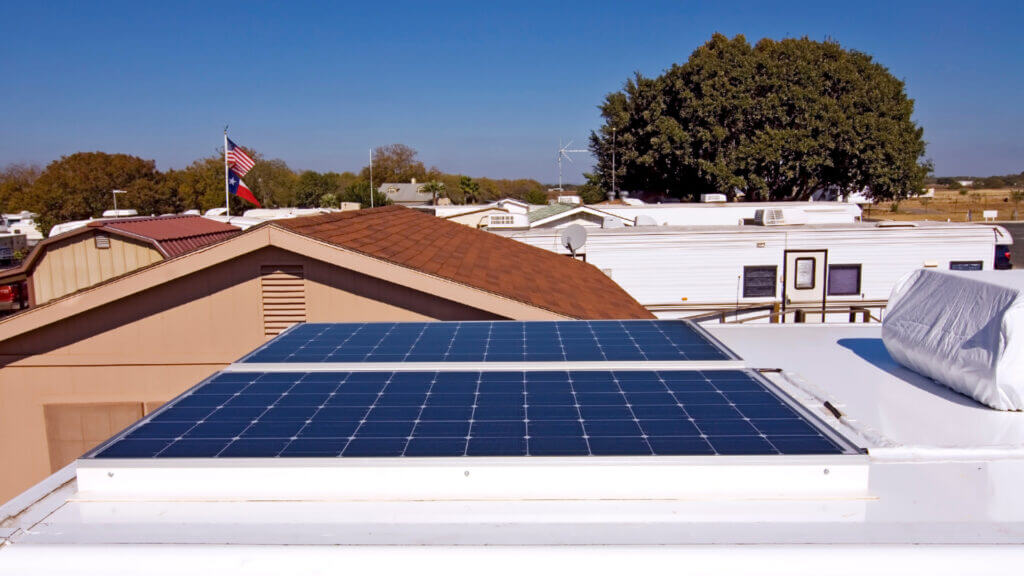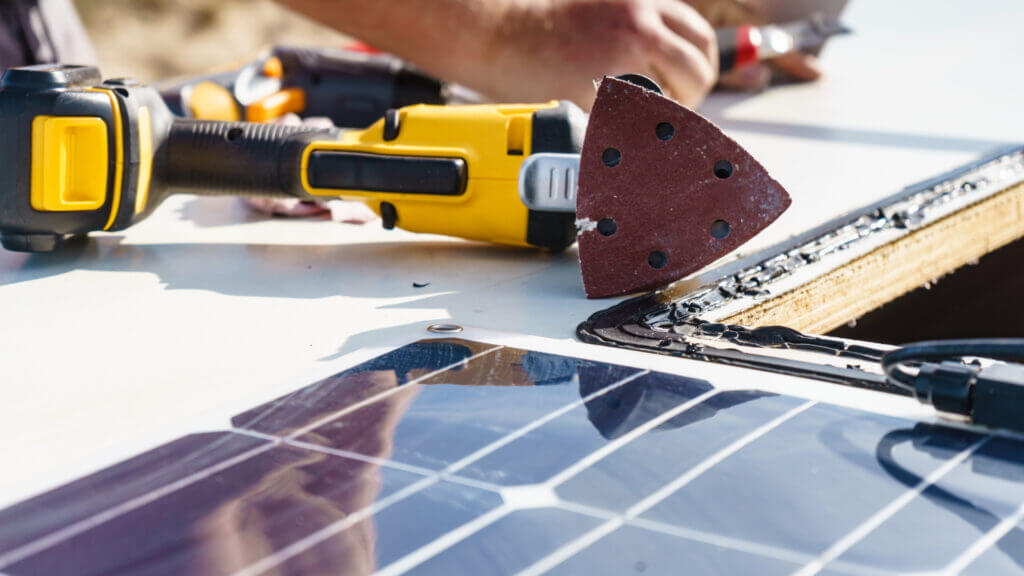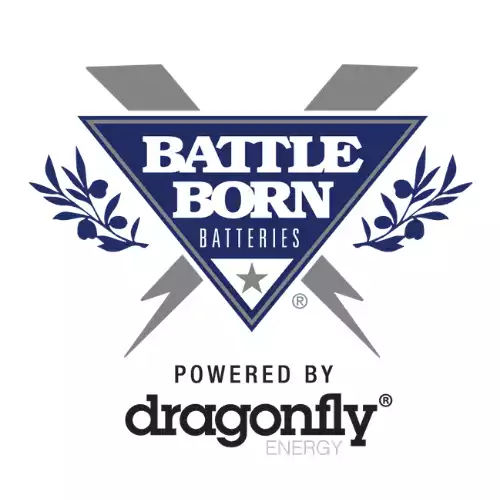Table of Contents Show
As camping without hookups (“boondocking”) becomes more popular, solar power is a hot topic among RVers. The concept of using the sun to charge RV batteries is inspiring more and more people to ask the question, “How much does it cost to install solar panels on an RV?”
What Are the Benefits of Solar on an RV?
There are enormous benefits of harnessing the power of the sun to power your electrical needs!
First, you’re using renewable energy, and that’s good for everyone. If the sun is shining and you’re beneath it, you’re replenishing the power in your batteries. Consider the absolute magic of this concept. Your battery bank receives a constant feed of pure, clean energy as long as the sun is shining on your solar panels. And you don’t need a noisy generator. This is “awesome” at its finest!
With solar, there are fewer emissions. Well, there are NO emissions, a far cry from running a generator or a vehicle engine to charge your batteries.
And finally, freedom is a crucial benefit of having a solar system. You don’t have to tether yourself to campground connections, and you’re free to boondock anywhere the sun shines.
Key Components of a Solar Installation
As you can see, there are multiple benefits to having a solar system. But what does that system consist of, what does each component contribute to the system, and how much does it cost to install solar panels on an RV? Let’s find out!
There are four main solar system components that you’ll need to create energy for your RV, van, or travel trailer.
Solar Panels
Perhaps the most apparent component of a solar system are the solar panels. Depending on the size of your rig’s roof and your budget, your solar system can use one panel or several. There’s no other limit to the number of panels you can use, though you’ll have to match the other system components accordingly.
Solar panels can be either flexible or rigid, fixed or portable. The pros and cons of each depend on your specific application.
You can use a single folding solar panel that you carry inside your rig until you’re parked, then set the panel in the sun to harness its energy. Or you can mount one or more rigid or flexible panels on the roof of your rig.
Flexible panels tend to retain heat that accumulates beneath them, and they don’t last as long as rigid panels. But for some roofs and some applications, flexible panels are the best choice.
You mount rigid solar panels with brackets that lift them off the roof’s surface, so the heat retention is far less due to the increased airflow underneath. It may impact gas mileage to some degree, but it also prevents heat buildup.
Rigid solar panels work very well, and you can shift their angles either manually or electronically to take full advantage of the sun’s position at any given time.

Charge Controllers
A charge controller is a vital part of an RV solar system. It serves as a voltage/current regulator to keep your batteries from overcharging.
As mentioned in the previous section, most so-called “12-Volt” solar panels put out approximately 16 to 20 volts in reality. The panels need to provide extra voltage so that you’ll still get some power output when the sun is low, you’re parked, you’re driving under cloud cover, or you’re in high ambient temperatures.
Most batteries only need around 14 to 14.5 volts to charge fully. So if you don’t use a charge controller to regulate your battery bank’s input, overcharging will damage your batteries. Your charge controller serves as your voltage regulator.
A charge controller can also automatically disconnect non-critical loads from the battery if the voltage falls below a certain level. It can block reverse currents, preventing the battery from discharging at night when it’s dark as well.

Battery Storage
Your battery storage is the third critical component of your RV solar system. Batteries store energy/electricity when your solar panels aren’t generating more.
There are various battery types available for solar storage, including different lead-acid batteries (the oldest tried and true battery technology out there) and lithium-ion batteries (newer, more advanced battery technology). The latter is quickly becoming the top choice for RV solar systems.
Your batteries should be in a well-ventilated area of your RV or van, isolated from living areas because they emit hydrogen and oxygen gas during the charging process. They should also be away from temperature extremes and located where you can easily access them for maintenance and replacement.
Your battery bank’s size will depend on your ideal solar system size. You can have a single 60-100 watt solar panel on your roof and one storage battery, or you can have multiple solar panels putting energy into numerous batteries to make up a vast battery bank.
Battle Born Batteries offers a full line of lithium-ion batteries. Whether you simply want a drop-in replacement for your current battery or want a reliable off-grid system for some serious boondocking, they have you covered. We've used and abused our Battle Born Batteries for years and can confidently say lead is dead.
Inverters
Your battery bank will put out 12-Volt DC (direct current) power. DC flows in one direction only, unlike AC (alternative current) that flows in both directions. Some electronics and appliances require 120-Volt AC to operate. Devices and appliances that may need 120-Volt AC include things like your laptop, television, coffee maker, microwave oven, space heater, Instant Pot, etc.
The inverter takes the 12-Volt power from your battery bank and transforms it electronically to 120-Volt AC power.
Your inverter size depends on your solar system size and what you need to power when boondocking/dry camping in your RV.
A 100-watt solar panel with a small charge controller, a single battery, and a 250-300-watt inverter will run your TV, for example.
If you want to run a residential refrigerator and several other devices and small appliances (not all at once), however, it’s a different story. You’re looking at several solar panels in an array, a beefier 96-amp charge controller, a large battery bank, and a 2000-watt inverter.
And running an air conditioner will require a massive 4000-watt inverter plus bigger everything else in the system!
What Does It Cost for a Complete RV Solar System?
The above scenarios illustrate various RV solar system sizes depending on what you need to power. The cost will grow with the system sizes. It’s all about the number of amp-hours you’ll need in 24 hours.
So let’s use our hypotheticals above to look at potential costs.
The solar kit described above that will run your TV would cost you around $200-250, not including the battery.
Suppose you’re getting a 400-watt solar kit, two or three batteries, and a larger capacity inverter to run your fridge and several appliances. In that case, you’re looking at $600-700 dollars, not including the batteries or battery monitor.
The most extensive RV solar system we described above will cost anywhere from $2,000 to $5,000+. Extra solar panels, remote controls, and other extras will increase the cost even more.
Additional Cost: Having Someone Else Install Your Solar System
The cost of having someone else install your RV solar system can be pretty substantial because most installers charge $100-$150 per hour. Labor time depends on many factors, including your solar system’s size and the installer’s experience.
If you’re installing a relatively small system, the installation costs will pale compared to a large, complex solar installation, which can take 10 or more hours to install.

Who Should Invest in Solar for Their RV?
Let’s start with who should not invest in RV solar: campers who prefer campgrounds with full hookups and amenities. They don’t have power conservation worries, fresh water concerns, or holding tank capacities. Solar becomes irrelevant for them.
On the other hand, campers who enjoy boondocking will be grateful for an RV solar system, even if it’s just a 60-watt panel and a single battery.
Full-timers who camp in RV parks and boondock will also dramatically benefit from solar panels. You’ll be making a significant investment in a solar system initially, but it’s more than worth it for the lifestyle.
Will You Rely on Solar?
The question “How much does it cost to install solar panels on an RV?” is, as you can now see, complex and depends on several factors. The answer largely depends on how you like to camp and the amount of power you need.
If you’d rather boondock constantly, but you have to stop at campgrounds because you need power, a solar system will pay off. It’ll last for many years while you’re boondocking, enjoying nature, and harnessing the incredible power of the sun while avoiding those nightly campground fees.







